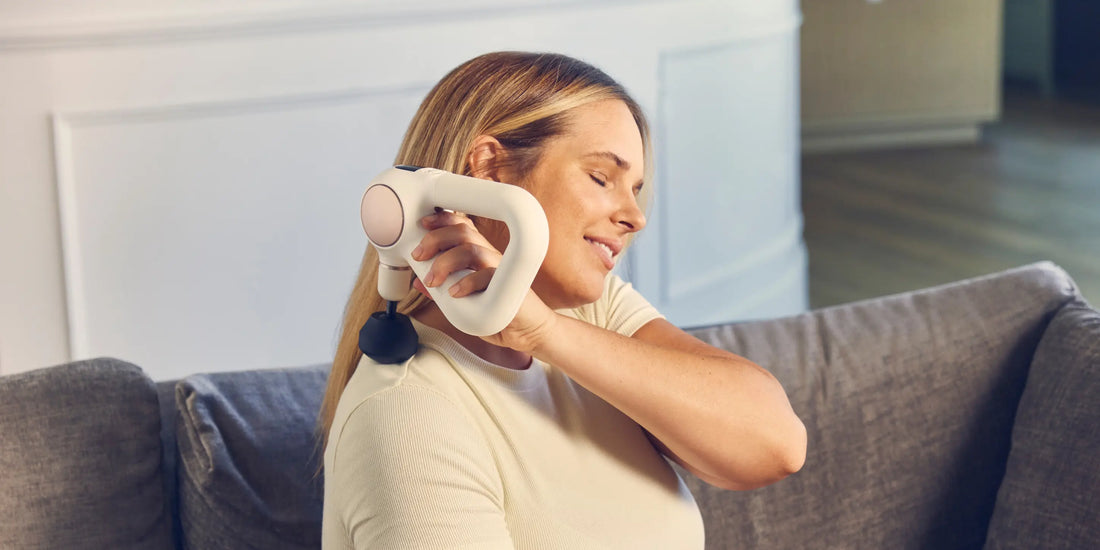
How Lifestyle and Technology Can Accelerate Recovery From Exercise
Authors: Therabody Scientists: Tim Roberts, MSc; Kyle Silvey, PhD; Michelle Darian, MS, MPH, RD, LDN
Recovery is the body’s intentional pursuit of better health, wellness, and performance. The body is resilient — and designed to recover, both physically and mentally, naturally. Therabody has technology that is purposely designed to enhance and expedite recovery. Leveraging the science behind the body’s natural restorative processes, Therabody has created an ecosystem of devices that can enhance the body’s natural healing processes — to get you back to the activities you enjoy the most, faster and stronger.
Learn more about the science behind recovery, why recovery is a critical component of any exercise and wellness routine, and the science behind recovery treatment technology.
What Does Recovery Mean?
Recovery is a term often used, but its meaning is nuanced. At its core, recovery encompasses both mental and physical health. Rather than a purely restful state, recovery is an active process of returning to baseline after exertion or stress.
The body constantly ebbs and flows between effort and stress compared to recovery. And the body is resilient, with natural adaptive processes to handle stressors. However, prioritizing recovery enables more effective responses to subsequent challenges.
And now, because of the technological and scientific evolution of the last two decades, technology can enhance the recovery process — allowing us to take control by integrating lifestyle and technology to expedite recovery.
Why is it Important to Recover Post-Exercise?
Allowing the body to recover can help facilitate both mental and physical adaptation to exercise and help reduce the risk of negative outcomes like illness and injury. Here are a few specific benefits to prioritizing recovery. [1, 2]
- Improved Athletic Performance: Recovery allows the body to adapt and get stronger. Exercise causes microscopic tears in muscle fibers and tissue damage. Proper rest and recovery give the body time to repair this damage and adapt, getting stronger for the next training bout.
- Prevents Overtraining: Rest days and recovery periods are needed to prevent overtraining, burnout, and potential injury. Overtraining can lead to decreased performance.
- Reduces Injury Risk: Recovery allows exercise-related aches, pains, and injuries to heal properly. Exercising through pain often exacerbates injuries. Adequate recovery time can help avoid stress fractures and impact injuries.
- Helps to Build Muscles: Recovery days allow protein synthesis and muscle building to occur after the microtears from exercising are repaired.
- Improves Mental Readiness: Remember, recovery is both physical and mental. Recovery provides mental recharging to maintain motivation and focus for upcoming workouts and races. This helps avoid mental fatigue.
What Does Recovery Include?
Because recovery is an active process, your actions can help to expedite the mind and body’s recovery. Here are five lifestyle habits that can help to expedite exercise recovery.
Implement Rest Days
Taking rest days or time between bouts of activity is critical for proper recovery. Depending on training schedules, volume, and intensity, aim to incorporate 1-2 rest days per week to allow the body to adapt to stresses. Incorporate low-impact activities like walking, yoga, and stretching into your training routine to facilitate recovery by increasing blood flow without excess strain. It is also important to prioritize extra rest after intense training sessions, competitions, or when fatigue sets in. [1]
Get Adequate Sleep
Consistently getting a good night’s sleep is an import component of physical and mental recovery. Striving for 7-9 hours of sleep per night allows the body to repair tissues broken down during exercise, consolidate memories, and replenish energy stores. Maintaining consistent bedtime and wake-up time sets the body up to sleep better. Strategies like limiting exposure to blue light from screens, keeping the bedroom cool, and managing stress can further enhance sleep. [3]

Prioritize Nutritious Foods
Nutrition plays a major role in recovering from exercise. Consuming carbohydrates paired with protein within 30 minutes post-workout helps to replenish glycogen stores and facilitate muscle repair. When you’re working out, you expend energy (also known as calories, which are a unit of energy). It’s critical to replenish the energy lost through your workout by eating more calories. Eating a meal post-workout also fuels recovery processes like muscle repair. Getting enough quality protein at each meal helps to stimulate muscle protein synthesis, which accelerates the rebuilding of muscle fibers broken down during training and builds muscle. Examples of protein-rich foods are eggs, poultry, fish, plant proteins like quinoa and beans, and supplements like protein powders.
Anti-inflammatory foods rich in antioxidants and omega-3 fatty acids like fruits, vegetables, fish, and healthy fats can help to improve fatigue and promote muscle tissue healing. Aim to avoid refined sugars and excessive alcohol, which can impede recovery. [4]
Intentionally Rehydrate
Proper hydration is key to proper recovery. Because sweat results in the loss of electrolytes like sodium and potassium, sports drinks can help restore electrolyte balance. When training in hot environments or at high intensities, bump up water intake to offset heightened fluid losses from sweat. [5]
Practice Breathwork
There are many scientifically supported benefits of breathwork on the mind and body. Breathing deeply and slowly, allowing the diaphragm to expand and contract on each inhale and exhale, stimulates the parasympathetic, or the “rest and digest," system. Deeply inhaling through the nose sends signals to the brain to activate relaxation pathways, lowering stress in the body. In fact, slow, deep breathing exercises can stimulate the parasympathetic nervous system and lower heart rate. A reduction in heart rate can help the body to relax and recover. [6]
Tools To Accelerate Recovery
In addition to lifestyle habits, the use of technology can help to expedite recovery processes. Combining lifestyle habits with these recovery modalities allows the body and mind to bounce back quicker physically and mentally. In fact, certain technologies and modalities can actively accelerate the body’s natural recuperative processes. Here are five types of technology that can accelerate recovery.

Foam Rolling
Foam rolling provides several powerful benefits that aid athletic recovery. The pressure applied during foam rolling helps to break up muscle knots and scar tissue. It increases circulation by stimulating blood flow to the muscles being rolled — bringing nutrient-rich blood to the fatigued muscles to help repair damage. The improved circulation and tissue repair provided by foam rolling can significantly decrease soreness and alleviate muscle tightness. Overall, frequent foam rolling helps accelerate active recovery, reduces post-exercise soreness, and primes the muscles for optimal function. Integrating foam rolling into a training program allows dynamic, active individuals to stay fine-tuned. [7, 8]
Heat, Cold, and Contrast Therapy
Applying heat, cold, and alternating temperatures through contrast therapy are effective modalities that can enhance post-workout recovery. Heat therapy widens blood vessels to increase blood flow, which can help to reduce stiffness and soreness and ease muscle tension after strenuous activity. Conversely, cold therapy narrows blood vessels — which can reduce inflammation, swelling, and pain in fatigued tissues. Contrast therapy alternates hot and cold therapy, combining therapeutic benefits for maximum recovery. During contrast therapy, the heat increases blood flow and circulation, while the cold alleviates inflammation. Using these temperature-based treatments helps remove metabolic waste, delivers nutrient and oxygen-rich blood for repair, reduces stiffness and soreness, and expedites recovery by stimulating the body’s natural healing processes. Integrating heat, cold, and contrast therapies actively accelerates the body’s recovery after a workout. [9]
Infrared LED Light Therapy
Research shows that red and infrared light enhances tissue repair and strength. Light therapy improves wound healing while boosting collagen production and content in both healthy and damaged tissues. These effects translate to muscle recovery — infrared light therapy applied to muscles can accelerate healing after intense exercise. Infrared light’s long wavelength can penetrate beneath the skin’s surface, reaching as deep as muscle tissue. This light therapy also increases collagen production, which can provide greater tissue strength and resilience to withstand a high training load. Incorporating light therapy into recovery routines can help maximize muscle recovery between training sessions. [10]
Pneumatic Compression Therapy
Pneumatic compression devices utilize targeted air pressure to facilitate post-exercise recovery. These systems feature inflatable sleeves or garments that wrap around limbs and inflate in a pulsing or sequential pattern. This compression helps blood and lymph fluid circulate better. Increased circulation brings more oxygen and nutrients to the muscles to help them recover faster. It also removes waste products that build up post-exercise. The improved circulation and flushing of waste products reduce swelling, soreness, and stiffness. Pneumatic compression is an excellent example of a technology that boosts the body’s own recovery system to maximize recovery. [11]

Percussive Therapy
Percussive therapy uses targeted pulsing vibrations to provide multiple benefits that accelerate recovery. This treatment increases blood flow to muscles, enhances tissue mobility, reduces soreness, and even stimulates relaxation of the nervous system. Through repeated pulsing vibrations, percussive therapy helps flush out metabolic waste, deliver nutrient-rich blood to treatment areas, and ease muscle tension. Percussive therapy allows both the mind and body to bounce back quicker after intense exertion — maximizing the body’s restorative capacity. [12, 13]
Key Takeaways
- Recovery is the active process of restoring physical and mental health after exercise or stress. Prioritizing recovery enables more effective adaptation and resilience to exertion.
- Adequate recovery enhances athletic performance, prevents overtraining, reduces injury risk, builds muscle, and improves mental readiness.
- Rest, nutrition, hydration, sleep, and intentional breathwork are lifestyle habits that facilitate recovery.
- Technologies like foam rolling, temperature treatments, LED light therapy, pneumatic compression, and percussive therapy are examples of technology that can enhance and accelerate recovery.
References
- https://pubmed.ncbi.nlm.nih.gov/18202569/
- https://pubmed.ncbi.nlm.nih.gov/29755363/
- https://pubmed.ncbi.nlm.nih.gov/31288293/
- https://pubmed.ncbi.nlm.nih.gov/26166054/
- https://pubmed.ncbi.nlm.nih.gov/11131686/
- https://pubmed.ncbi.nlm.nih.gov/29209423/
- https://journals.lww.com/acsm-msse/fulltext/2020/07001/the_effect_of_percussive_massage_or_foam_roller.3093.asp
- https://pubmed.ncbi.nlm.nih.gov/31256353/
- Denegar, C. R. (2000). Therapeutic modalities for athletic injuries. Human Kinetics Publishers.
- https://pubmed.ncbi.nlm.nih.gov/29090398/
- https://link.springer.com/chapter/10.1007/978-0-387-45951-6_70
- https://pubmed.ncbi.nlm.nih.gov/34360032/
- https://pubmed.ncbi.nlm.nih.gov/37020441/




